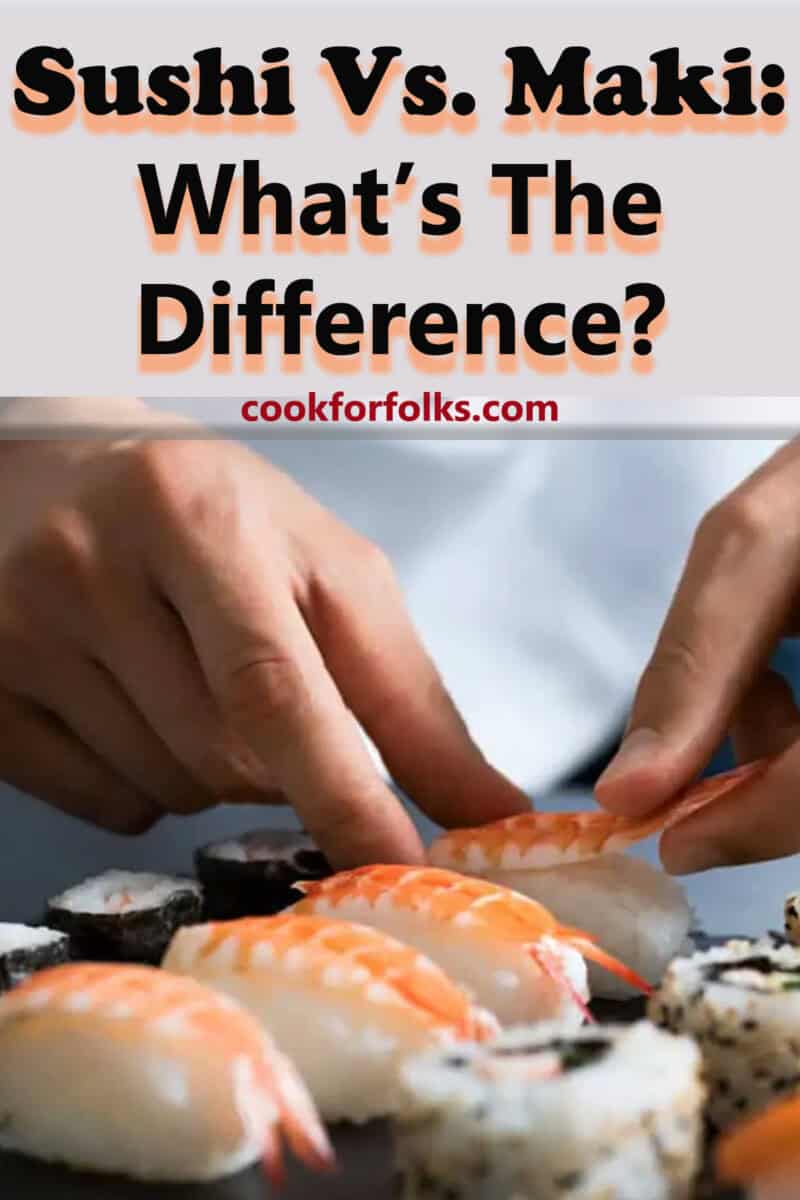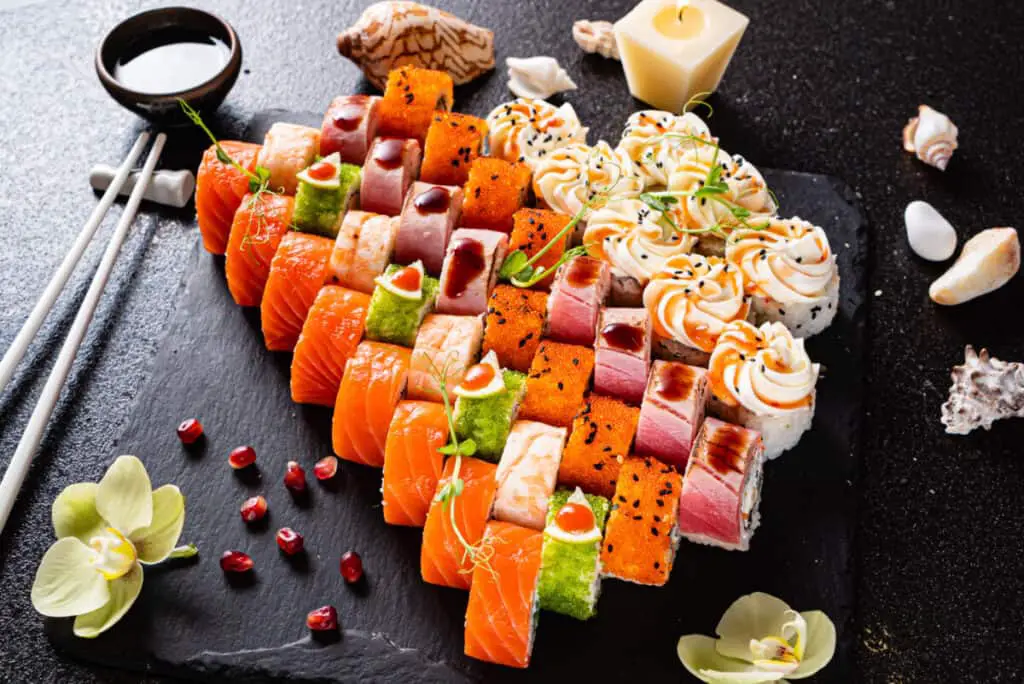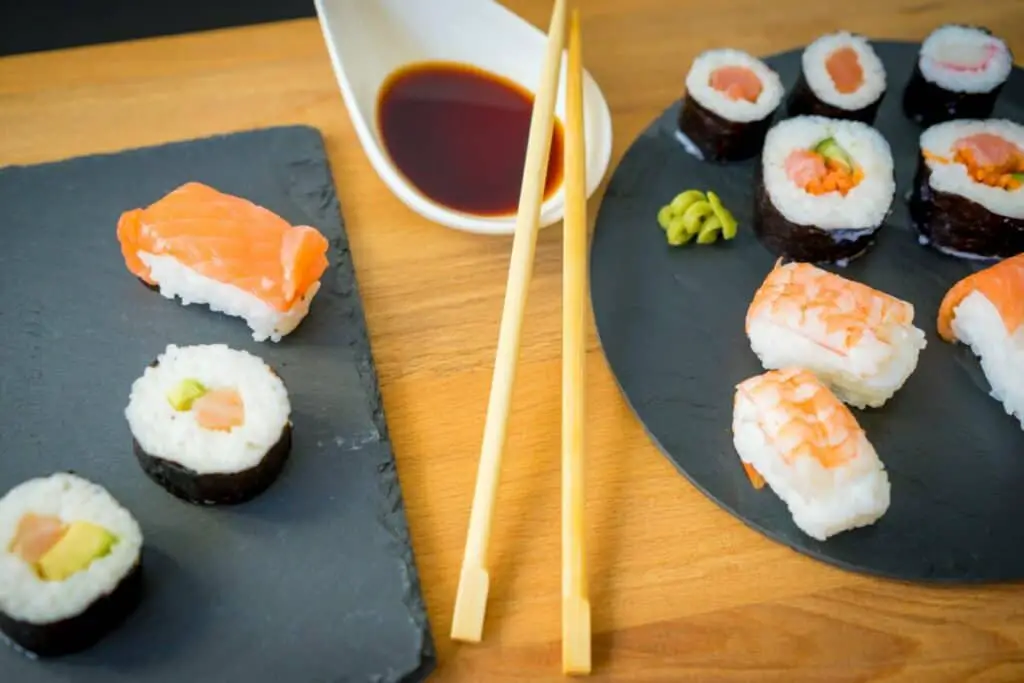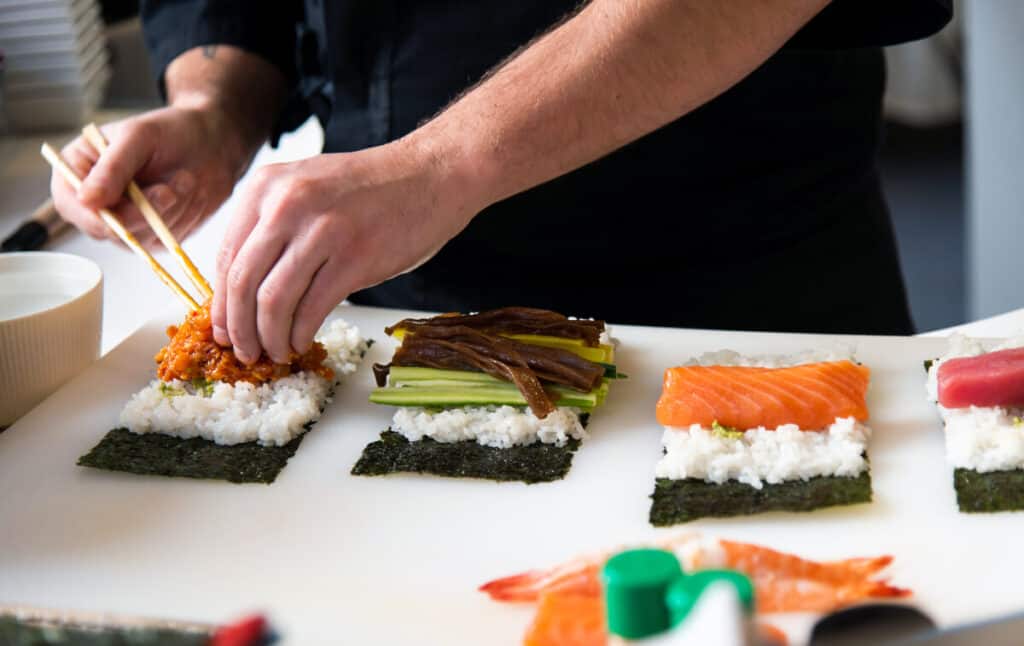This post contains affiliate links.
Sushi has got to be one of the best foods out there! It’s delicious, fun, and unique. With so many different kinds of sushi, what is maki? What’s the difference?
Sushi is defined as anything with vinegar flavored rice paired with raw seafood or meat. Maki is a type of sushi where vinegar flavored rice is wrapped around raw meat or seafood with other ingredients, which is rolled in seaweed and cut into bite size cylinders.

The difference between the two isn’t a big one, but it can definitely help you better navigate the world of food! Gain a better appreciation for your meals with this handy guide.
What is sushi?
What is sushi? Most people can easily point to some at a restaurant or on a grocery store shelf, but can’t define exactly what it is. It has rice, but so do lots of other dishes from all around the world! Sushi is also famous for its use of raw meat, specifically seafood like tuna and shrimp, but it isn’t the only food to utilize raw ingredients.

What defines sushi is actually the rice base seen is all different kinds of sushi! Sushi is made using vinegar flavored rice that is then paired with other ingredients, usually raw meat and vegetables.
How the sushi is paired with that meat defines what kind of sushi it is, because there are actually multiple kinds of sushi prepared in different ways.. For example, one of the simplest forms of sushi is nigiri, which is a small bed of rice topped with a piece of raw seafood.
Although sushi is Asian in origin, it has become a booming market in the US, with nearly 16,000 restaurants as of 2022. Sushi is traditionally prepared with raw fish or shellfish, but it can be made with cooked meat or something that isn’t seafood. You can also make vegetarian sushi without meat. It just won’t be as authentic.
Sushi can be made with any kind of rice, but long grained white rice is the most common. Sushi is eaten using chopsticks, which are best equipped to hold the sticky rice and all of its toppings.
Sushi is a fun way to learn more about the food styles and preparation from other cultures, and a delicious tradition that will last for a long time!
What is maki?
The difference between maki and sushi is a rectangle and triangles situation. Maki is sushi, but sushi isn’t always maki. Maki is the kind of sushi that is usually depicted in popular media, and the first image to pop into someone’s head when they hear the word sushi.

Maki is made when ingredients like meat and vegetables are wrapped in a layer of rice, then rolled in a sheet of seaweed. This long maki roll is then cut into bite size pieces and eaten with chopsticks.
The size of the maki pieces isn’t constant, but usually has a diameter of one or two inches and isn’t more than an inch tall. Maki is a more complicated preparation of sushi which requires more ingredients, but has a beautiful look and great taste!
The filling of maki can be anything, from fish to shellfish to vegetables. The seaweed wrapping, called nori, is rolled onto the maki using a flexible bamboo mat. You layer the ingredients onto the mat over the seaweed, and roll it up tight to keep the roll from falling apart.
There’s a lot of flexibility with the preparations for maki, which include one to however many filling ingredients you want to add. For a little pizzazz, you can also brush sesame oil or sprinkle sesame seeds on the maki roll.
Maki rolls are a great way to experience sushi and explore all the different flavors offered by this dish! You can also personalize maki with your favorite sushi ingredients to get that perfect combo of meat and vegetables. With so many options, maki is sure to please everyone!
Maki is one of the most convenient ways to eat sushi as the rice is tightly wrapped in the seaweed, and stays together more easily. It’s also one of the most beautiful and iconic forms of sushi, with clear cut layers and bright colors hinting at the ingredients. It’s a fun and gorgeous food to enjoy when you’d like something a little out of the ordinary!
Major differences between sushi and maki
The major difference between maki and sushi is that maki is just a kind of sushi, but there are several other kinds of sushi out there! Maki has several ingredients snuggly wrapped in rice and seaweed, but not all other kinds of sushi are this elaborate. Sushi is any kind of food paired with vinegar flavored rice, so there are several ways to eat it.

Sashimi, for example, is thought of as sushi isn’t actually, because it doesn’t include the vinegar rice. Sashimi just refers to thinly sliced pieces of raw fish or meat, a common ingredient in sushi and maki.
There’s also nigiri, which is a small mound of rice topped with sashimi.
Uramaki is like maki but inside out, with the seaweed wrapping the ingredients on the inside and the rice on the outside. Temaki is also like maki, but prepared with one’s hands instead of a bamboo mat, giving a more cone like shape instead of a perfectly round one.
Oshizushi is made by pressing the rice with layers of ingredients, to make a sort of sushi layer cake. It’s like a more ornate version of nigiri, which also layers rice and meat.
With all these, and many other kinds of sushi I haven’t even mentioned yet, what sets maki apart is the roll with rice wrapped in seaweed, made cylindrical with a bamboo mat.
All these kinds of sushi have their own pros and cons, from how difficult it is to prepare to how good it tastes to how much you can customize with your own combination of ingredients! All of them are good choices, so you’ll have to see for yourself what the best sushi is. Finding out is half the fun!
History of sushi
Sushi has existed in one form or another for so long it’s unclear when and how it was first invented, but currently, it is considered a Japanese food. Historians believe that sushi was first created in China over a thousand years ago, and was shortly afterward introduced to Japan, where it took off enough to claim Japan as its permanent home.
Sushi was eaten at first because the fermented rice would keep the raw meat and fish from going bad by pickling it, which meant that sushi could be eaten long after the meat was butchered.
A thousand years ago, this was an amazing discovery, as keeping meat fresh was a difficult process that involved salting it, adding spices to kill off germs, or keeping it cold with ice. Sushi was an easy, cheap, and delicious way to keep that seafood edible for a longer period of time.
It could also be shipped over a distance, which was incredible at the time because not many high protein foods could be shipped and provide more remote areas with vital nutrition. Today, refrigeration means we no longer have to worry about keeping food in things like salt and fermented rice to keep it good.
In Japan, seafood is plentiful, which is why sushi tends to use ingredients like fish, shellfish, and seaweed. Sushi was one of the first fast foods in Japan, and is still an extremely popular fast food today. Sushi is often served in conveyor belt style sushi bars rather than fast food stands, however.
Sushi was introduced into the US by Japanese immigrants in the 1960’s. Early Japanese American immigrants would build restaurants selling what they knew best from their birthplace: food! Today, it is one of the most popular foods in the US, and a great way to share Japanese culture around the world!
History of maki
Like sushi, there isn’t an exact date for the origin of maki, but it is believed to have been invented around the 18th century. Maki sushi is popular because it’s easy to portion and pack to eat later.

One urban legend claims maki was invented by the yakuza, the Japanese mafia. Unable to eat sushi while playing cards, they rolled it in seaweed to make it easier to eat.
Maki is definitely easier to eat, since the snug seaweed wrapping keeps everything inside the roll together. Food all around the world is frequently designed to be easier to make, ship, or eat. Rice in sushi can easily fall apart when handled, so maki is helpful on top of being delicious!
Maki is one of the most easily recognizable forms of sushi because of it’s beautiful arrangement and its popularity as a fast food in Japanese culture as well as Japanese American culture when immigrants first came to US and spread their favorite hometown meals. It was popularized in California, which is why some sushi is called a “California roll”.
How to prepare sushi
One of the biggest ingredients for sushi is the main ingredient: Rice! You can use any kind of rice you want, but medium to long grained white rice is the most traditional. Sushi rice is mixed with vinegar and occasionally salt and sugar as well, which flavors the sushi and keeps the fish good. If you’re using raw meat, make sure you handle it carefully and use sushi grade meat that is safe to eat raw.

Cut the meat into sashimi, or thin slices of meat. You can use cooked meat if that’s all that’s available or you would prefer it to be cooked. You can even skip the meat and make a vegetarian sushi.
Besides meat, you can really add whatever you want to sushi, like avocado, eggs, or cucumber. There are many different ways to make sushi, so you can choose which kind you want to make based on difficulty, taste, ingredients, and more!
Some sushi recipes require specific tools to prepare or present the sushi, like bamboo mats, so read through the recipe carefully and make sure you have everything you need in advance. Once you have your sushi rice, your meat or other ingredients, and you know what kind of sushi you want to make, carefully arrange your ingredients and prepare your sushi!
Eat it as soon as possible to keep it tasting fresh, and keep sushi in the fridge to make sure it stays good. You can arrange your sushi to make it look as fancy as possible, and drizzle on a sauce of your choice that you think will go well with your recipe for sushi. Enjoy this Japanese traditional and delicious piece of history!
How to prepare maki
Maki is prepared a lot like other sushi! First you cook the rice of your choice and mix it with the vinegar and other ingredients like sugar and salt. When your rice is prepared, get your bamboo mat and flatten it down.

Place a layer of the seaweed (nori) on the mat, and spread the rice in an even layer over the seaweed. Then, add whatever other ingredients you’d like to the rice, and tightly roll up the sushi. Carefully cut the sushi into six to eight bit size pieces, and arrange on your serving platter.
You can add side dishes or dipping sauces like pickled ginger and wasabi to your sushi arrangement, and enjoy this delicious and fun food!
Sushi is a great way to learn more about other cultures, and different foods and their history. It’s also an insight into food from hundreds of years ago and how it was first developed and why.
The invention of sushi was a combination of ancient people learning how to make their resources stretch a bit further and later cooks and chefs making that food taste great. Food is a delicious insight into an incredible history!
Special thanks to Bonsai Sushi and Itto Sushi


